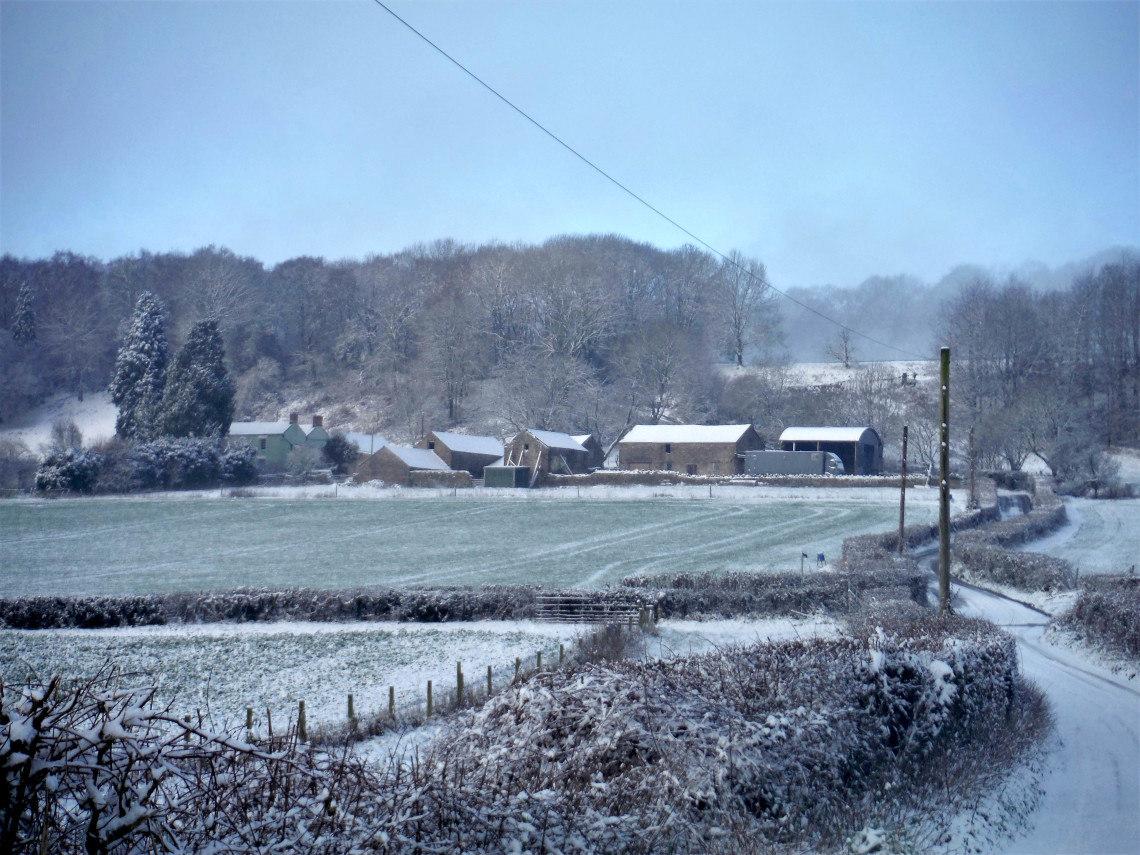After a warm and wet December, the New Year began with a few days of cold, dry weather. This had the effect at last of gradually reducing river levels to those much longed for grayling fishing conditions. However, for nearly all of us that pleasure was to be denied. Welsh anglers were still allowed to fish locally but prevented by their quarantine regulations from actually driving to the river or crossing the border. English anglers could drive their car, but it was suggested not further than five miles, and again no border crossing. In the circumstances it was obvious that there would be very few opportunities for the usual winter grayling and coarse fishing. Most of us travel some distance to fish – in the case of my own grayling fishing, usually 50-70 miles and usually across the border.
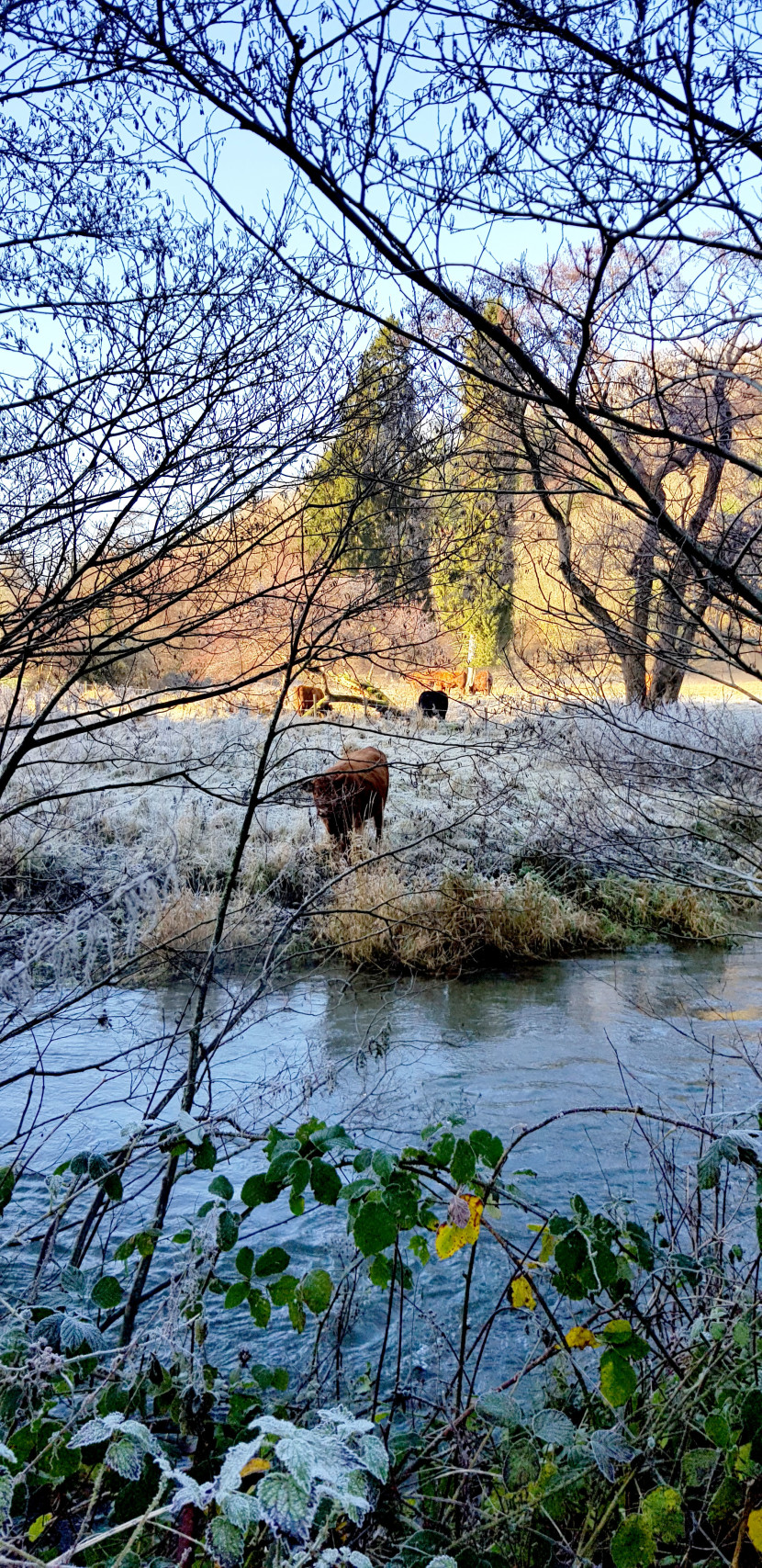
Meanwhile members of our Forest Syndicate carefully read the words of the UK Government’s instructions for a new lockdown for England beginning on 5th January. We could leave home once a day for the healthy and desirable purpose of exercise, “….including, but not restricted to, running, walking, cycling and swimming.” That would be something, the local members thought, having read through the press release. Provided we did not stray too far from home and stayed apart from others, it was clear enough that we could cast a fly rod for rainbows in our local lake for an hour or two, as well as cycle round it, walk around it, or even swim in it. A couple of hours of fly casting on a frosty morning, particularly for elder anglers such as we, should compare well as exercise with walking the dog or digging the allotment.
Given the uncomplicated wording of the government instruction, the Angling Trust then caused a bit of a shock by writing to their members asking them to stop fishing at once. 48 hours later, another message came countermanding the first, advising that solitary and local fishing could continue. Having got past that problem, we were left again with the situation that both English and Welsh anglers might fish once a day as their exercise, provided the venue was local and there was no border crossing. At least now there was some parity between the two sides of the border. As a result of the government decision we had some quite good rainbow trout fishing for a while, to the extent that some of us eventually held back to avoid over-pressuring the pool.
Faced with the travelling ban, the WUF decided with another heavy sigh to close the on-line booking office until the present lockdown restrictions are lifted. I gather they will still be open to calls from anglers who really do live close to the river and wish to make an arrangement which will not involve travel. Teaching and guiding has stopped for now. Meanwhile, venues such as commercial fisheries, shooting grounds and golf clubs will also remain closed. Sunday morning shooting at clay pigeons is another little avenue of pleasure which I am certainly missing.
All of the above concerns must seem very petty and selfish considering the effect of lockdown on people who live in cities and who cannot even reach the countryside, let alone enjoy it. I admit that those of us who are lucky enough to live in rural areas should be thankful for small mercies. I’m told that city parks are now becoming quite crowded by families trying to get some daily fresh air and we should hardly be complaining. It’s a true privilege to be able to walk on the hills and through woods, and while normal life is on hold, there are compensations, activities which we never had enough time for. Inside the bubbles, parents are seeing a lot more of their children. Others in our family are working, so I have taken on the role of cook. I’m getting rather good at it, although I say it myself as shouldn’t and admittedly it is with the support of the Hello Fresh food delivery company. I reckon my penne pasta al forno is at least as tasty as used to be served at Newland’s famous Ostrich Inn, which is any case closed for the duration. I may even take up smoking rainbow trout again; smoked trout pate on ciabatta rolls anybody? Meanwhile Nerma and I took one look at each other and made a unanimous decision to pass on the “dry January” idea as soon as we heard about it. I drink a beer while I cook and she has a gin and tonic while she watches. I remembered that even during a Greek Lent, when for religious reasons country people reckon to live on beans, nobody would dream of giving up wine.
In the circumstances, there has been no news of grayling fishing to report although I dare say a few lucky anglers who live right on the river managed to get out. Storm Christophe on the 20th brought very high floods to our valleys again and even coloured the lakes brown with surface run-off. We also had some cold snaps and even snow. The pool was half frozen for a couple of days. More rain and snow is predicted, for after all this is mid-winter. For now I have included some pictures of our winter rivers, which are effectively lying fallow. On reflection this may do their grayling population no harm at all. We had some better than usual spring trout fishing after our lock-down last year.
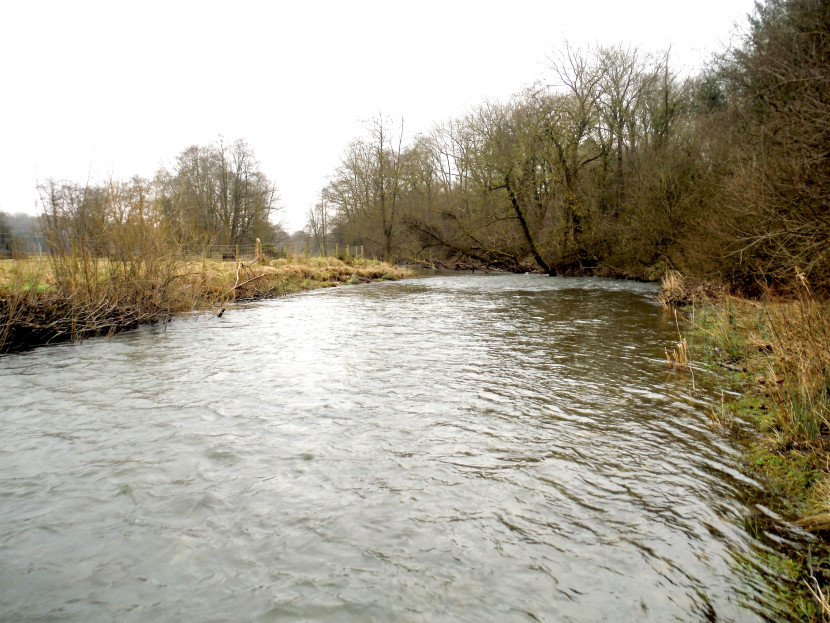 Ithon
Ithon 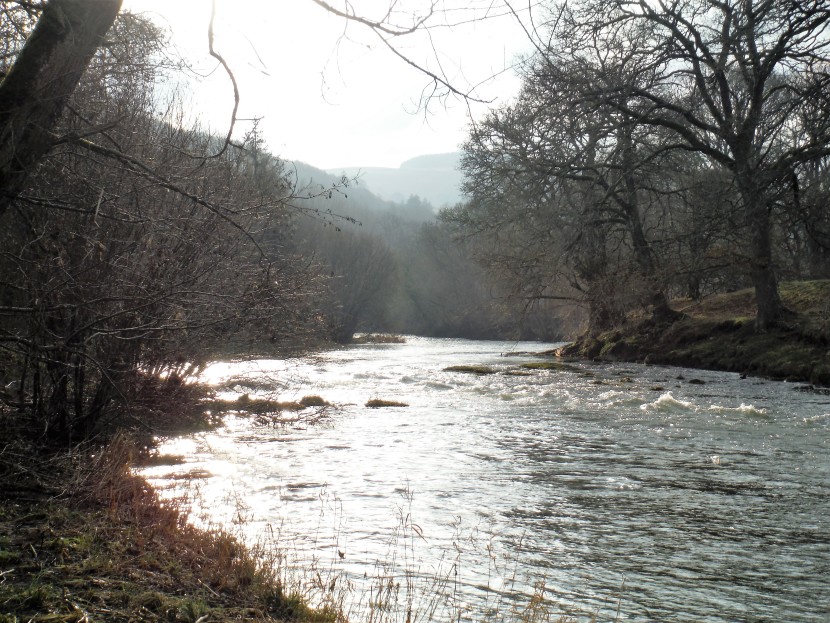 Cefnllysgwynne
Cefnllysgwynne ed.jpg?w=830) Wye grayling
Wye grayling Meanwhile we must wait until we receive the green light and a date for the lock-down restrictions to be relaxed. Until that happens and the WUF reopens the booking office, I am afraid we are unable to make new firm arrangements with fishing clients and I must apologise to those who inquired about cold weather grayling fishing, trotting etc; it seems that it just won’t be possible this winter. I have been hoping for some news by late February and perhaps being on the river for spring trout and salmon fishing by March, but that may prove optimistic. There are even some current speculations that the lockdown might run until the end of the summer. The Government, wiser than before perhaps, is avoiding invitations by the media to paint itself into a corner by speculating too much on dates, and hopefully will reserve to itself the right to make a decision based on the data and advice received at the time. Meanwhile, there is no shortage of unasked for advice; doctors seem to disagree with each other as often as members of any other profession, particularly when invited to a media interview.
Here’s a matter of interest: where do grayling come from? Or to put it another way, how did grayling get to be where we find them today? Why are grayling present only in certain British rivers? Locally we have them in the Wye, but not the neighbouring Usk. For that matter why are there no grayling in Ireland? At the same time the brown trout, our other popular angling species, has found its way or been introduced to almost every piece of water where pollution levels and temperatures permit its survival. Why do brown trout (with a very few exceptions) do so much better in lakes than grayling? Why are there no grayling in the southern hemisphere even today? (There is in fact a creature known as the grayling in Australia, but that has no connection with our familiar Thymallus).
The questions are many and the answers far from obvious. Clearly both grayling and trout are Arctic species, and we know that both originate from the northern hemisphere along with some closely related fellow travellers including various types of salmon and char. If we take the brown or European trout first, we know that it is a relatively young species, “plastic” and adaptable to different environments. The wide range of colour variations to be found in brown trout is evidence enough for that. In fact, to try and simplify the matter, the differences in behaviour and characteristics between the three northern hemisphere trout species is not that great. Only three trout species on the planet? Strictly speaking, yes. It has been put thus: “There’s brown trout, there’s rainbows and there’s cutthroats. Everything else is char.”
One great adaptive facility which we now understand that the various trout share, is the capability to go to sea, even if they must return from salt to fresh water in order to spawn. Another is to move upstream in the river and leap over barriers and falls of a reasonable height. Thus if a river mouth has been unobstructed and free of ice, at some point in time sea-going trout have had the opportunity to swim up it for spawning purposes. Since the last ice age, this facility has given trout the opportunity to colonise almost all places in the northern hemisphere where temperatures would support them. Transplanting by man completed the work in the southern hemisphere, where over the last 150 years viable trout populations have been established in every continent except Antarctica.
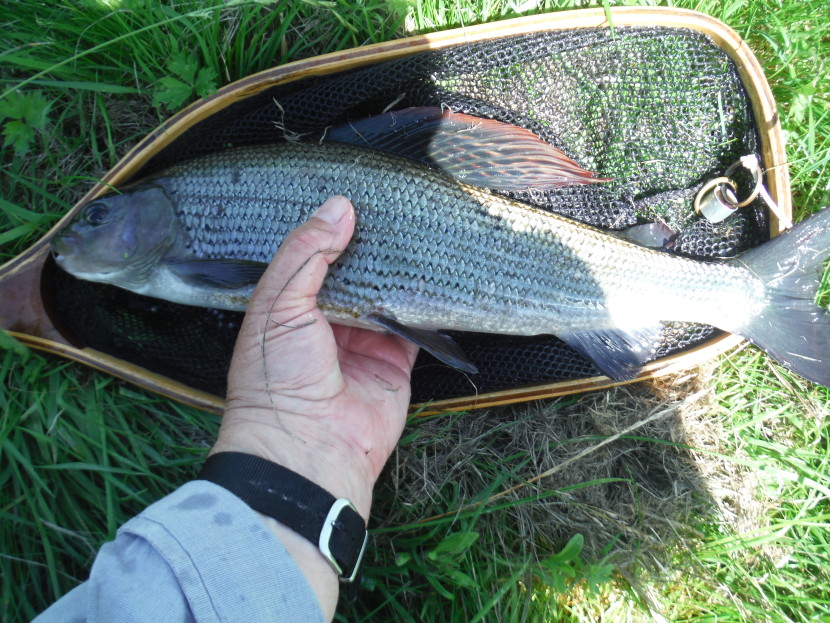 Avon grayling
Avon grayling  European grayling from the Arrow
European grayling from the Arrow 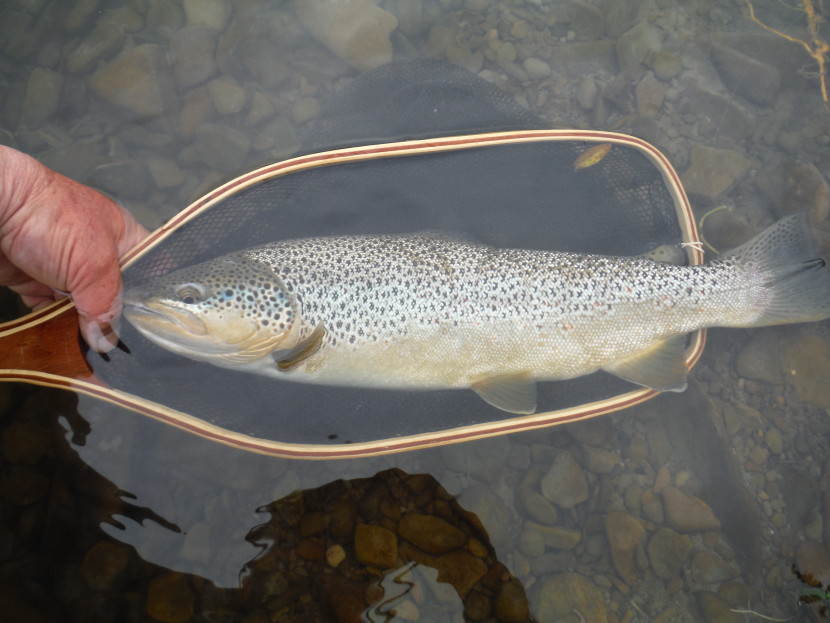 European brown trout
European brown trout Grayling, on the other hand, are an older species and less adaptable. They have a close relative in Canada, known as the “primitive white fish,” also a recognizable salmonid with an adipose fin. They are somewhat more sensitive to water pollution than trout. Very importantly, while grayling are found in some brackish parts of the Baltic, they do not have the trout and salmon’s ability to access fully salt water and thus colonise new river systems. Nor are they very good at getting over falls and obstructions; some quite modest weirs have been found to limit the movement of grayling populations, of which there are basically two in the world. These are the European grayling, which can be found from Britain in the west as far east as the Urals, and the Arctic grayling which encircles the rest of the hemisphere, through Siberia east from the Urals to the Pacific and on across Alaska and Canada to the Atlantic. There are several sub-species of Arctic grayling: the Mongolian and Lake Baikal graylings, the Montana grayling, and a population once inhabiting Michigan, which probably became extinct at some time over the last century. None of these populations are ubiquitous; they are not present in every river system. Look at the accompanying global population diagram made by Ross Gardiner (from The Complete Book of the Grayling, Ronald Broughton, Robert Hale, 1989). If we remove the introductions known to have been made by man, this general pattern is the grayling population which survived the last ice age and shows the extent of subsequent colonisation which the species managed unaided.
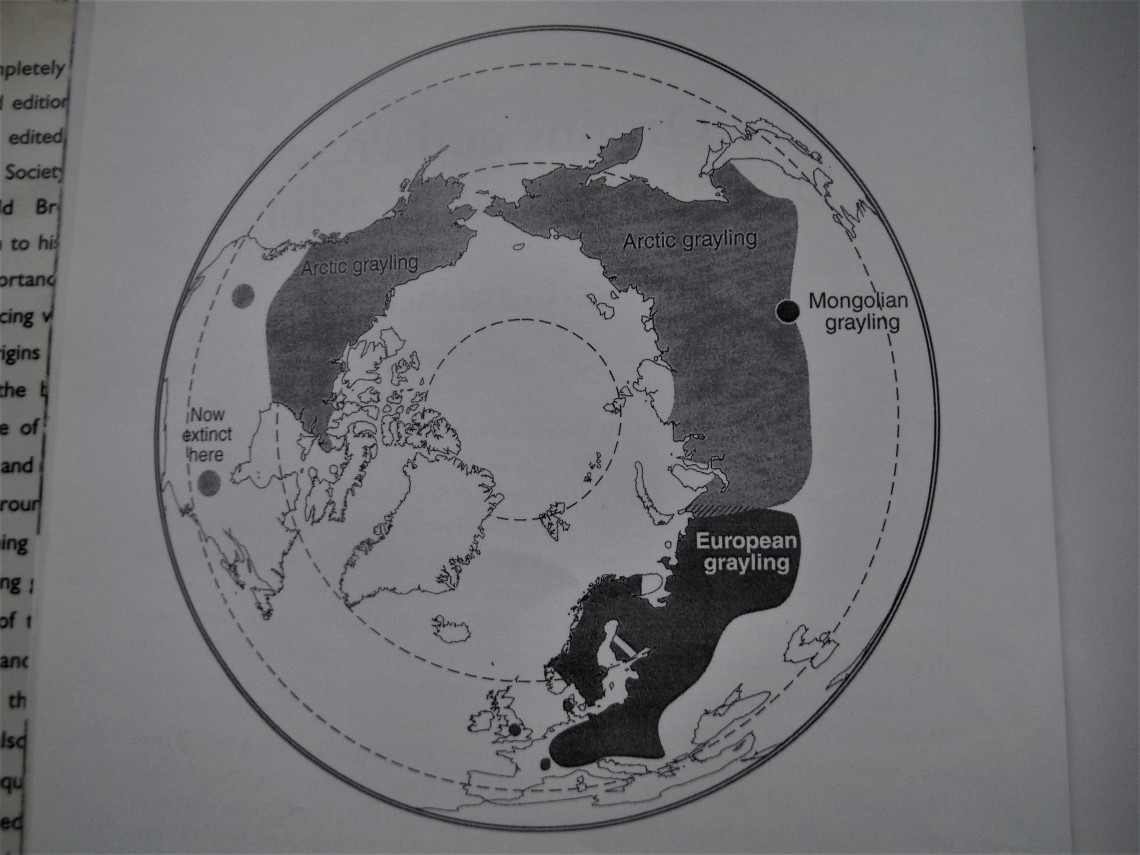 Grayling distribution
Grayling distribution Now let us consider the distribution of British grayling. Historically they seem to have been present in many eastern rivers, but few on the west coast and there are still no grayling in Ireland. We know quite a lot about where grayling were introduced by sportsmen, mostly during the 19th century: by Canon Eagles into the Monnow for example, into the Test and Itchen supposedly from the Hampshire Avon, into the Exe, Barle and Tamar, and into the Ribble, Eden and Eamont. Grayling in the South Wales streams such as the Taff are also recent human introductions.
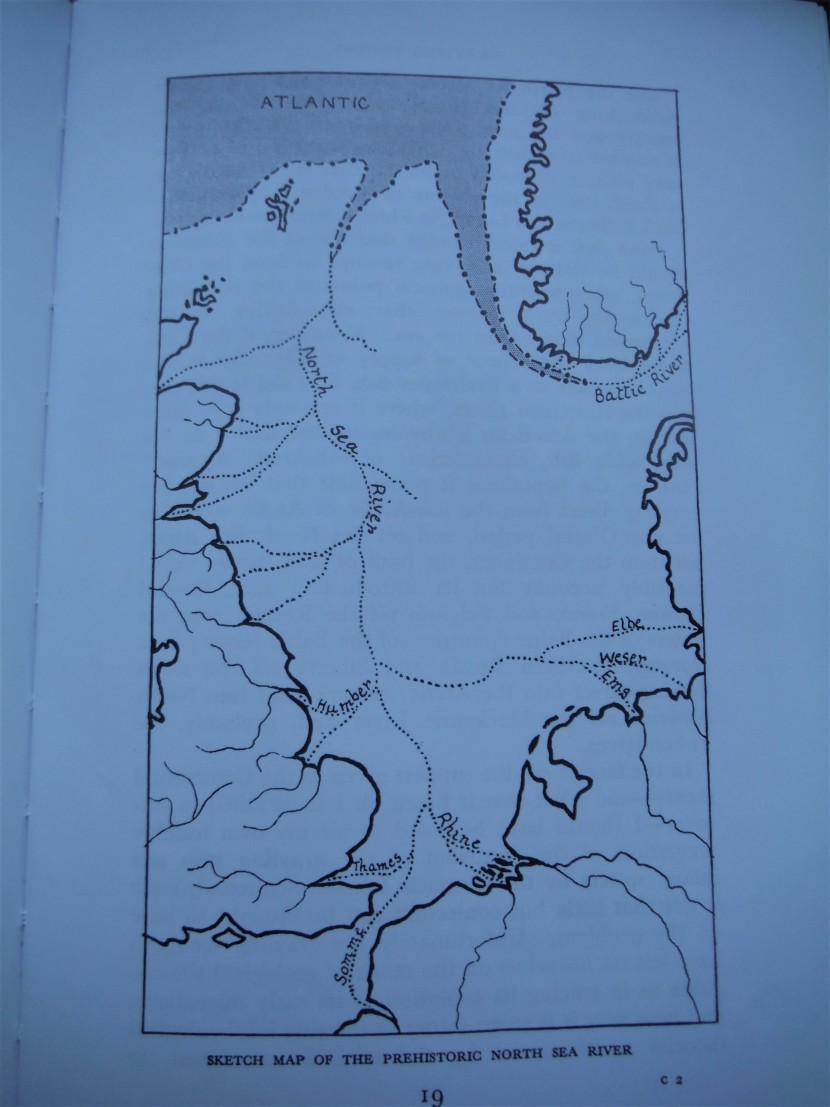
Look now at a second diagram, this one from William Carter Platts’ highly recommended book Grayling Fishing, (Adam and Charles Black 1939). This gives a sketch map of what is generally known as the North Sea River as it was in the Pleistocene epoch, a prehistoric period when Britain and the continent were connected by low-lying land, not just at the modern Dover straits, but filling in the whole of the North Sea. Effectively what is now Eastern Scotland was connected by land to Norway, and Britain as a whole was a broad peninsula of Europe jutting out into the Western Ocean. The Great North River once draining this basin is no imaginary modern concept and the course of its bed can still be traced today by taking soundings in the shallow North Sea. Following this giant river starting from its beginnings, we find that considerable tributaries still exist today as independent river systems, although the main channel has disappeared into the sea as the lowlands flooded. Thus the Somme coming up from the south was joined by the Thames from the west and the Rhine from the east, followed in due course by the Humber and the Wash rivers coming in from the west, and the Elbe, Weser and Ems from the east. Continuing north, the Great River gathered in the Tyne and then all the tributaries of eastern Scotland (Tweed, Tay, Spey, Dee and more) before reaching the Atlantic coast somewhere north of the modern Shetlands. This estuary was next to that of another giant river draining the flatlands which are now the Baltic. Such enormous bodies of moving water must have been an amazing sight, equivalent in size to Orinoco or Mississippi. The first humans in Europe would have roamed their banks, as would mammoths, cave bears and other strange creatures.
Here is the fascinating part of the Carter Platts theory: all of the surviving tributary river systems mentioned, naturally as far as we can tell, contain grayling. Today’s Northern European grayling, he posits, are the natural survivors of the prehistoric Great North River remaining after the last ice age, plus some extra population transplants due to modern human intervention. There are some oddities which take a bit of explaining. One obvious one is that both Severn and Wye have always contained grayling as far as we can tell, and yet they are both westward flowing. They didn’t flow into the Great North River. Or did they? Carter Platts explains this with the theory of tributary capture, which is generally approved by modern geologists. During upheavals and depressions of the land, the upper waters of rivers often combined or stole from each other before parting again. Thus the Severn on occasions had connections with the Wye, the Trent, the Thames, and possibly also the Hampshire Avon. Not only the water, but fish species too would have been captured at such times of upheaval and diversion.
Why there are no grayling in the southern hemisphere, I am honestly not sure. I am not even clear that anybody has ever tried the transplantation. Compared with other salmonids, grayling are not that easy to strip and breed in an artificial environment, although I can remember Bibury Trout Farms making some experiments with them. Usually the introductions which have been made consisted of transferring adults from one water to the other and letting nature do the rest over time. The two books mentioned should be available from Coch y Bonddu Books, and the Carter Platts one is particularly recommended for original thoughts on grayling and grayling fishing. Meanwhile, salute the next grayling you catch with respect; it is a representative of an ancient race.
Years ago, when she first came to this country, my wife already had a thorough working knowledge of the language – she took English Literature at Sarajevo University and later worked as an interpreter during the war – but there were certain peculiarities of pronunciation which used to catch her out. I remember the name Hayes presented a problem. “Total Fishing is on the television,” she would put her head around the door and say. “You know, that Matt Hayees you like to watch.”
Well, I did and do like to watch Matt Hayes, who is one of those rare people with an inborn knack of talking to the camera. I always liked the early shows when Matt was on his home patch, barbel fishing somewhere near Bewdley with the smoke of the Severn Valley steam train showing in the background, or after winter grayling at the top of the Severn near Caersws. They tell me he used to fish the lake in Lydney Park for carp. Later came Ireland, trips in a camper van and such exotic ideas as chasing great white sharks. Apart from the fact that he is obviously a very good all-round angler, his television shows inject just the right amount of technical advice combined with that rather nice banter between the slightly extrovert jack-the-lad Matt and his modest, low-key and very likeable pal Mick Brown. Basically it’s about Matt gently teasing Mick, and all of it in that distinctive accent of the West Midlands. At the same time, Total Fishing was a strangely classless show for a British one. At least they avoided too many “awesomes” and “personal bests” along with overdosing on the guitar and drum music film-makers cannot seem to resist now. I can remember once they ran a skit on what they called “posh” anglers, dressing up in dinner suits to play and net a carp while Matt sounded off like the Duke of Somewhere or Another about his supposed beat on the Spey. It was all so silly that nobody could be offended and I remembered thinking to myself that surely they realised that a genuine aristocrat would probably be fishing the Spey or indeed the carp pit in the scruffiest of old clothes.
In fact, as Jim Coates’ recent interview in January’s Trout and Salmon made clear, Matt’s working life has moved into full-time salmon fishing, as he and his Norwegian wife have managed a beat and accommodation on the world-famous Gaula for a while now, and built up an enviable reputation to boot. Now he says his perfect “last day of your life” fishing trip would be dry fly fishing for brown trout, or maybe a night after sea trout. One thing in the article made me smile. Early in Matt’s Norwegian salmon fishing period, he wrote an article with quite a list of innovative Scandinavian-style salmon flies in different colours. As I recall, these were mainly in the teardrop Templedog style, with long flowing wings of arctic fox and the like. I was certainly encouraged to tie up a few of these exotics at the time. You know how it is; however much you already have faith in your existing patterns, there is always the temptation to tie up a couple of something new, just to try them out. Now, after a few years at the salmon game, Matt has another, much simpler, opinion about salmon flies and in the interview he mainly wanted to talk about Willie Gunn tubes. He quoted the advice of a friend, Lawrie Hickman: “He said he’d never yet fished a river where a Willie Gunn wouldn’t work – and don’t try to cast further than you can.” Wise words, I don’t doubt.
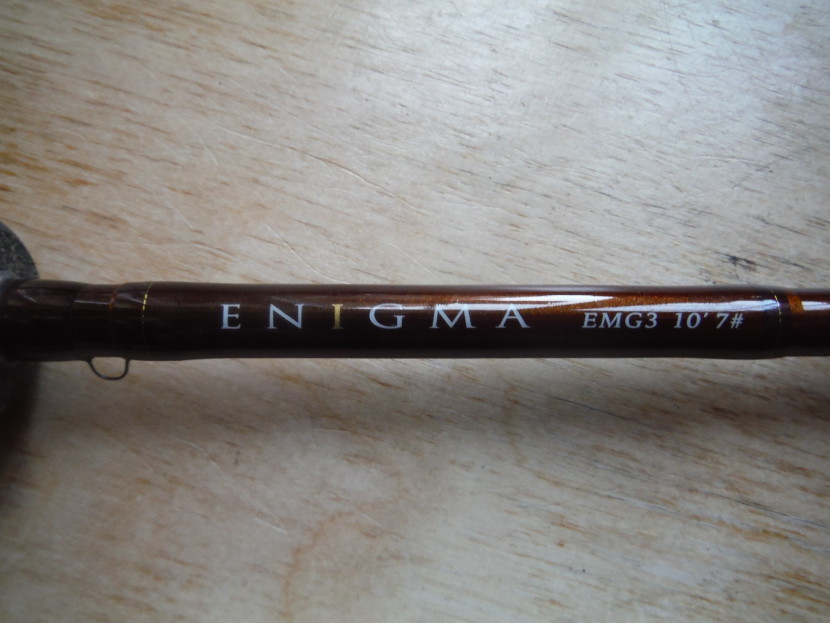
In February’s Trout and Salmon editor Andrew Flitcroft has a sad story to tell about breaking his Enigma 10ft 7 weight rod, companion of many sewin-fishing nights. Worse to relate, he finds now he can’t buy another. I can sympathise, and I don’t suppose it will be any comfort to Mr Flitcroft to know that I also have the same rod and am deeply fond of it. Designed and made in Wales specifically for night sea trout fishing, over many years the Enigma has earned a high reputation among practitioners of the dark art. I’m sorry Mr Flitcroft, mine is not for sale!
What is so good about the Enigma? There are certain concessions to night fishing in that there are no bright or reflective components, everything about it being coloured dark maroon or black, but the real advantage is its character as a rod with “feel” which assists in casting a variety of lines and heavy flies in the dark. It has no more than a middle to tip action, is not that fast compared to the latest modern rods, and weighs a little more for its length than we have become used to lately. It’s a tough and reliable companion for roaming around in the night. That is not to say that it is the only suitable rod for fishing in the dark; my own second rod which has accounted for several big sewin and also pleases me much is a more tip-actioned Grey’s Platinum X 10ft 7 weight. Others speak very highly of their favourite Loomis GLX or a Sage XP. A few years ago I acquired my Enigma from Fishtec – the gentlemen at Brecon once supplied me with a new tip section under warranty when carbon on the old one began to separate – but I dare say Mr Flitcroft will have tried that source of supply.
It seems there is a row brewing about salmon fishing in Iceland. The Monaco-based British billionaire Sir James Ratcliffe has been buying up thousands of acres in the north of the island which gives him access to some prime Atlantic salmon rivers. His “Six Rivers Conservation Project” now involves around 39 Icelandic farms and makes him the biggest single landowner on the island. Perhaps not surprisingly, there has been a local reaction and a call for legislation to limit Sir James’ holdings. Since English aristocrats brought salmon fishing to Norway during the 19th century – several of the best Norwegian rivers are still in British hands - there must be some natural sense of objection to wealthy English milords buying up the best of it.
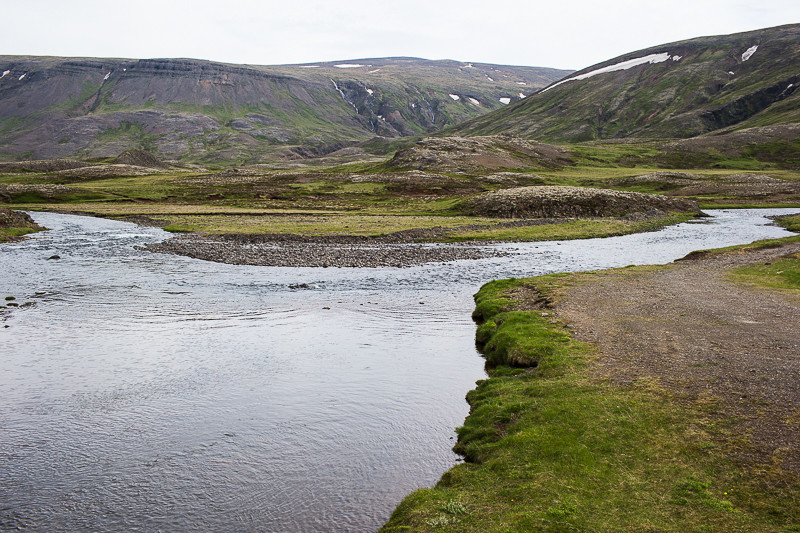 Pristine rivers
Pristine rivers I have never been fortunate enough to go fishing in Iceland, although I did some business with a firm in Reykjavik in my youth (Iceland is or was a small but valuable market for Landrover parts). I had the impression of a land of very independent people, a place so small that almost everybody knows everybody else. They certainly like to know whom they are dealing with. Iceland’s modern history may give a clue to the way they welcome outsiders with a warm handshake but certain reservations. At the outbreak of WW2 the island was a Danish dependency with the Danish monarch as head of state. When Denmark was occupied by Germany, Iceland declared itself to be neutral. Given its strategic location and the deadly nature of the unfolding Battle of the Atlantic, that was never really going to be possible. Britain landed a small force and a British military occupation eventually gave way to an American one. The invasion was bloodless, but Icelanders were not given a choice. The island was effectively an Allied harbour, air-base and refuelling station during the following war years. Reykjavik, a town hardly larger than Guildford, developed a lively night-life between British and American soldiers and local girls, which inevitably earned some disapproval from conservative islanders. Russell, former secretary of our Forest Syndicate, told me some stories about those times. For several years he had served in the crew of a Short Sunderland flying boat based on Iceland which undertook thousands of miles of cruising above a featureless North Atlantic, sometimes for 12 hours at a stretch. He told me they never saw a single U-boat during all those long hours of flying and scanning the waves. Most importantly as far as he was concerned, the engines never missed a beat. On the other hand, he learned to salmon fish when off duty and caught no less than five of them on his first attempt. He also married an Icelandic girl. I think we can take it that Russell had what they used to call “a good war!” Iceland declared itself an independent republic as soon as the war was over.
Today local people claim they are uncertain of the exact purpose of Ratcliffe’s INEOS organisation and its Icelandic holding company? Is it purely defence of a threatened and vulnerable species? Is it a well-founded business project to put a sporting and eco-tourism portfolio together? Maybe it is both; Sir James also has interests in eco-tourism in Tanzania. The Icelandic project includes close links with a local angling club and the building of a number of fish ladders to ease passage over waterfalls. At the same time, Icelandic landowners, mostly traditional farming families, would naturally enough like to keep the ownership and income from fishing rights in local hands. They also argue that Iceland’s record to date on salmon conservation has been world-leading compared with other countries. Certainly the late Orri Vigfusson made huge achievements in international negotiations to benefit the salmon. So why, they say, is there now a need for foreign investment in Iceland to support the species? The same doubt could not be expressed about arctic Russia, where a similar foreign investment in sport fishing very likely saved the salmon population from being poached out of the Kola Peninsula. INEOS is mainly a petrochemicals and energy company, but also has interests in professional football, Formula One, yacht racing and cycling. We have just learned that its new Grenadier 4WD vehicle will not be built in Bridgend, South Wales, but in France. It will be interesting to see what results from the Iceland venture.
On frosty mornings at our Forest pool, between making casts I am in the habit of watching birds and this can be a distraction from fishing. The kingfishers have been lively; we counted no less than 7 of them the other day. A few mandarin ducks have turned up, as they often do in the winter from ponds higher up the valley. They look like painted wooden toys. A solitary greylag goose, this one half-tame, has also been visiting us lately. Given the tight constraints of the landing area surrounded by tall trees, he has to do a sort of “Khe Sanh landing under fire” approach, initially plummeting down out of the sky and then suddenly flattening out with his big webbed feet deployed as air brakes, just having enough runway space along the surface to come to a halt at the head of the lake. On the way out he has to start again at the head, takes the whole length of the lake to beat his way heavily into the air above the dam, and then makes a sharp left turn to follow the road where it cuts through the trees and so out of sight down the valley. Some of the other pools have noisy Canada geese, but we rarely see them. I have never once seen a swan on our Forest pool; I assume the landing strip just is not big enough for the avian equivalent of a Boeing 747. Rather sadly, by the Wye at Ross there is now the body of a swan which strangled when caught during floods in a forked branch. Now the gibbeted corpse dangles high from the tree and probably will for a year or two.
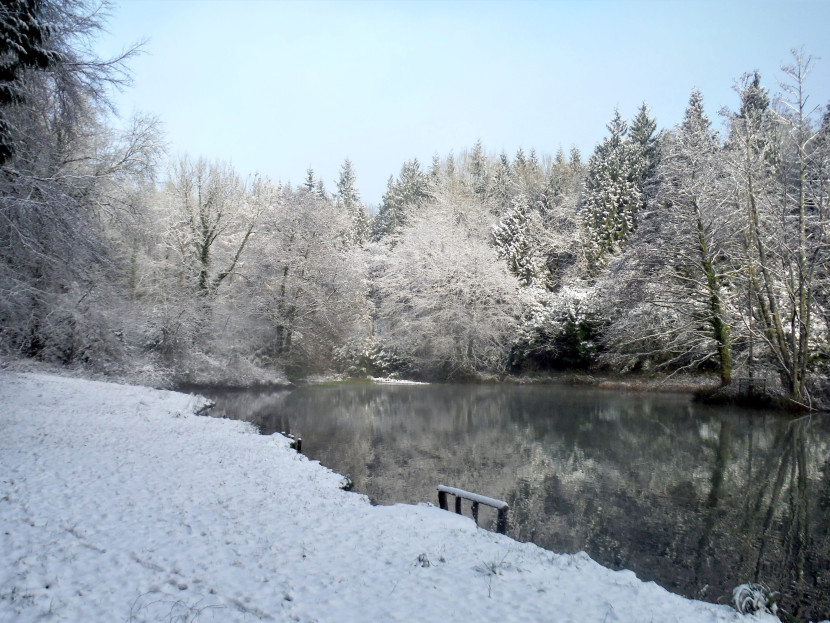 Forest pool winter
Forest pool winter 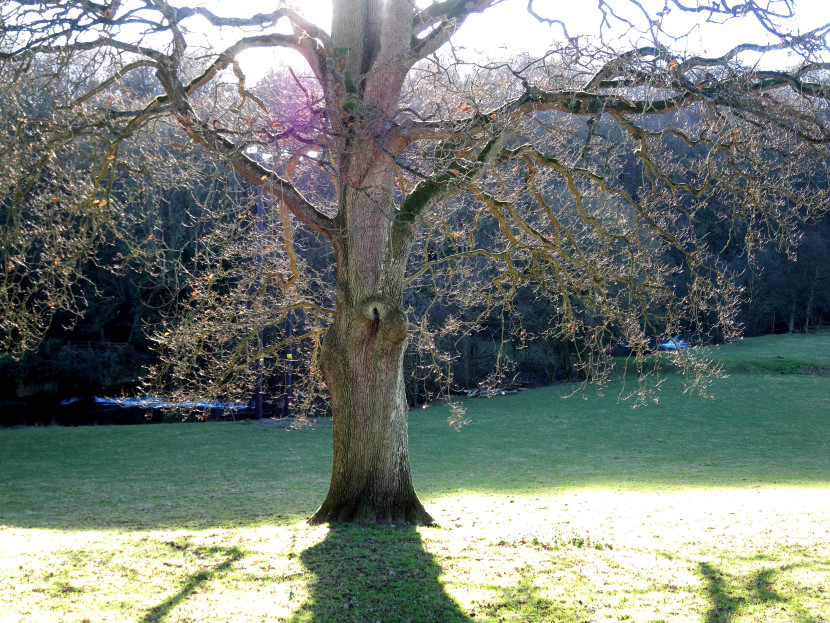 January in the Arrow Valley
January in the Arrow Valley There is so much we don’t understand about wild creatures or even the domestic creatures we breed and keep. To take one example which anglers might appreciate, it is often difficult to predict in advance whether shoals of rainbow trout are going to be lively or sluggish, or even at what depth in the lake they will swim. I know a man who always checks the goldfish in his garden pond to see what they are doing before he goes fishing: will they be on the surface or at the bottom? Or this might happen – the other morning I was fishing our Forest pool and it was one of those cold days when the rainbows don’t show much. They were clearly lying deep and feeling sluggish and I would probably have had most success with some kind of sinking line. In fact I was using a floater and a very long leader with a Goldhead Damsel, counting the fly down for about 20 seconds after each cast, and I was catching a deep-lying fish now and then. Nevertheless, for about two hours there was no movement at the surface anywhere on the lake. Then there was an unexpected swirl in front of me, a couple more further out, and when I looked round there were more rises about 50 yards away in front of the dam, and another one a similar distance in the opposite direction towards the head of the pool. All this happened within about 5 seconds, but as the rings were still spreading across the surface, the movements ceased as suddenly as they had begun. About then I picked up a fish on top, this time without counting down the fly. Why? What had provoked groups of fish a full hundred yards apart suddenly to come to the surface at the same time? I still don’t know the answer to that. There had been no sound or vibration, no hatching insects I could see, no sudden glint of sunlight, no new breath of wind to ruffle the surface, and for that matter no predator flying overhead that I had noticed. Yet some unknown factor had made those widely separated fish change their behaviour in unison for a moment.
Another example, and one which I have experienced many times. It’s quite common these days, at least on the Welsh rivers I know, to fish at night for sewin and nothing moves for hours. In the case of the Towy this is not a complete disaster and doesn’t mean that you won’t get a take at some time during the night. On the other hand it’s always encouraging when fish are visibly and audibly moving. All the same, imagine to yourself that this is one of the quiet nights. Then all of a sudden the silence is broken, a fish jumps right in front of you, another jumps 100 yards away, and for a few seconds the river seems full of life. And then the movement ceases, and again all is quiet, perhaps for the rest of the night. Why? It is sometimes possible to stir a sewin up into movement by fishing an unwelcome fly over it, and it may slash at the surface assuming it doesn’t take. Possibly an otter swimming by might have the same result. But surely neither event could have a simultaneous effect on fish a hundred yards or more apart? Did the moon go behind a cloud for a moment? What happened? Again, I don’t know.
I wonder, are the interactions of leaders and followers within the shoal involved in this behaviour? Rainbows and sewin (or at least the smaller sea trout) are both shoaling species, generally happier to move around in groups. I’m not sure I could identify leaders and followers, even in daylight and where the water is clear. But when the fish are so widely separated, how would a leader transmit a signal over such distances? We have all seen those oceanic documentaries of whirling shoals of bait fish under attack by predators. I have seen juvenile roach and rudd in a pond rotate in a similar pattern when predators are taking an interest. Is this a natural combination of fear/flight and clustering together, safety in numbers or the hope that another individual is the unlucky one to be taken? So it is said the unfortunate sailors of the torpedoed USS Indianapolis clustered together in the ocean while hunting sharks roved the edge of the group – a reversal of the usual hunter and prey situation.
Then there is that strange and inexplicable phenomenon I have sometimes seen in the Mediterranean countryside, when flocks of peacefully grazing sheep or goats suddenly spook and run for no apparent reason. It invariably happens in the middle of a hot summer day, when everything else appears to be asleep. The ancients ascribed this sudden fear of the beasts to the unseen (except by animals) approach of the god Pan, deity of herds and flocks; early Christians with a memory of the old gods described him as “the noon-day demon.” We can scoff at that idea, but we still have the word “panic” from it.
The question of movement and behaviour is more often asked by naturalists about flocks of birds and the strange and beautiful way in which some of them combine. First take a look at numbers of martins or swallows diving for insects over the river. The movement is charming to watch and encouraging for the angler, but evidently quite random. No leaders and followers there. But domestic pigeons and doves do seem to fly in unison. There is a dove-cot just down the hill from where I live; I can see it now from the office window and the sunlight often catches the birds’ white wings as they wheel in formation. Then make a comparison with starlings, particularly when they gather in large numbers at dusk. The Severn Estuary is famous for its starlings, birds which are now less common than they were, but over the flats you still sometimes see a huge flock which moves against the darkening sky like smoke, wheeling, pulsing and contracting, extending tongues of dark dots from the main body and pulling them back to the centre. This is rather delightfully called a “murmuration” of starlings. How do the birds co-ordinate with each other in this beautiful wheeling dance, is there a leader or leaders and is there even a purpose? One evening at sunset I saw a similar large number of starlings ahead of me after passing Abergavenny on the Heads of the Valleys road. The flock was filling the gorge above and pulsing against the light in the western sky almost like a giant jelly fish.
We could work our way through all the bird species which are not solitary and decide whether and perhaps how they co-ordinate movement. Flamingos, for example, when in large numbers make wheeling, scattering and gathering patterns almost as dramatic as do the starlings. That is not a sight I expect to see in the UK, but on Cyprus salt lakes and in the marshes near Cadiz I have done. Have you ever watched goosanders cruising on an English pond? They move like a well-disciplined naval flotilla, Napoleonic era warships switching 90 degree turns from line abreast to a column in perfect order. The purpose is a deadly one, to herd and corral fish in front of them, but who gives the order as they swim? They are more untidy in their formation when they take to the air, but there is usually a rough V shape to their group. In fact ducks often, geese and swans almost always, storks and cranes too, tend to fly in a V-formation when they are travelling any distance. There are perfectly good aero-dynamic reasons for that, which is why fighter planes adopt the same formation. It’s reasonable to assume that the leader or flight commander is in the apex position, with the wing-men taking their cue from any course alterations he makes – at least that is the way it works with aircraft.
I have a story for you which involves flying birds and is related to an anniversary coming up later this year, but that must wait until next month.
Stay safe!
Oliver Burch
